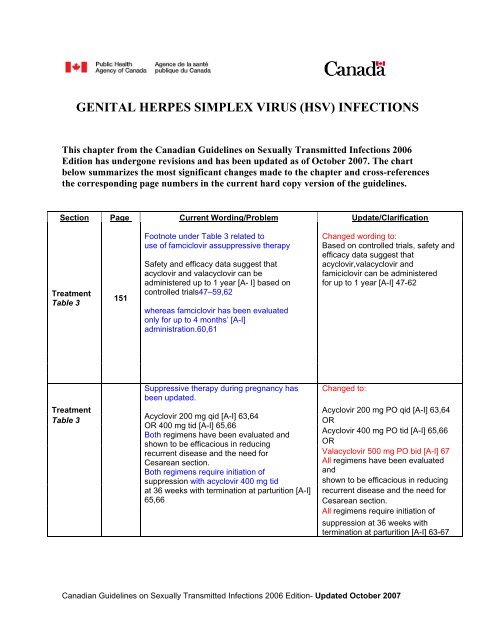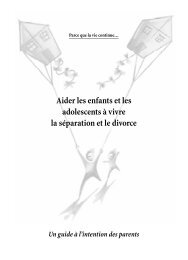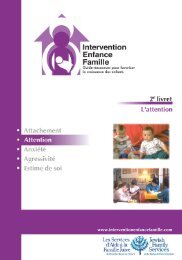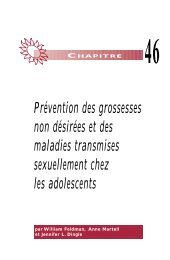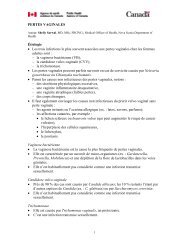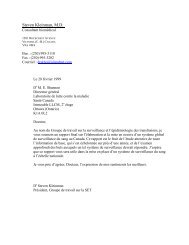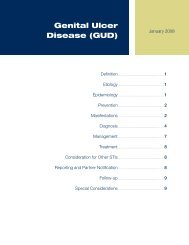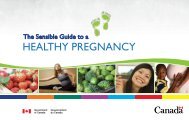GENITAL HERPES SIMPLEX VIRUS (HSV) INFECTIONS
GENITAL HERPES SIMPLEX VIRUS (HSV) INFECTIONS
GENITAL HERPES SIMPLEX VIRUS (HSV) INFECTIONS
Create successful ePaper yourself
Turn your PDF publications into a flip-book with our unique Google optimized e-Paper software.
<strong>GENITAL</strong> <strong>HERPES</strong> <strong>SIMPLEX</strong> <strong>VIRUS</strong> (<strong>HSV</strong>) <strong>INFECTIONS</strong><br />
This chapter from the Canadian Guidelines on Sexually Transmitted Infections 2006<br />
Edition has undergone revisions and has been updated as of October 2007. The chart<br />
below summarizes the most significant changes made to the chapter and cross-references<br />
the corresponding page numbers in the current hard copy version of the guidelines.<br />
Section Page Current Wording/Problem Update/Clarification<br />
Treatment<br />
Table 3<br />
151<br />
Footnote under Table 3 related to<br />
use of famciclovir assuppressive therapy<br />
Safety and efficacy data suggest that<br />
acyclovir and valacyclovir can be<br />
administered up to 1 year [A- I] based on<br />
controlled trials47–59,62<br />
whereas famciclovir has been evaluated<br />
only for up to 4 months’ [A-I]<br />
administration.60,61<br />
Changed wording to:<br />
Based on controlled trials, safety and<br />
efficacy data suggest that<br />
acyclovir,valacyclovir and<br />
famiciclovir can be administered<br />
for up to 1 year [A-I] 47-62<br />
Suppressive therapy during pregnancy has<br />
been updated.<br />
Changed to:<br />
Treatment<br />
Table 3<br />
Acyclovir 200 mg qid [A-I] 63,64<br />
OR 400 mg tid [A-I] 65,66<br />
Both regimens have been evaluated and<br />
shown to be efficacious in reducing<br />
recurrent disease and the need for<br />
Cesarean section.<br />
Both regimens require initiation of<br />
Acyclovir 200 mg PO qid [A-I] 63,64<br />
OR<br />
Acyclovir 400 mg PO tid [A-I] 65,66<br />
OR<br />
Valacyclovir 500 mg PO bid [A-I] 67<br />
All regimens have been evaluated<br />
and<br />
suppression with acyclovir 400 mg tid<br />
shown to be efficacious in reducing<br />
at 36 weeks with termination at parturition [A-I] recurrent disease and the need for<br />
65,66<br />
Cesarean section.<br />
All regimens require initiation of<br />
suppression at 36 weeks with<br />
termination at parturition [A-I] 63-67<br />
Canadian Guidelines on Sexually Transmitted Infections 2006 Edition- Updated October 2007
Genital Herpes Simplex Virus (<strong>HSV</strong>) Infections<br />
<strong>GENITAL</strong> <strong>HERPES</strong> <strong>SIMPLEX</strong> <strong>VIRUS</strong> (<strong>HSV</strong>) <strong>INFECTIONS</strong><br />
Etiology<br />
• Herpes simplex virus (<strong>HSV</strong>) types 1 and 2. 1<br />
Epidemiology<br />
• The annual incidence in Canada of genital herpes due to <strong>HSV</strong>-1 and -2 infection is not<br />
known (for a review of <strong>HSV</strong>-1/<strong>HSV</strong>-2 prevalence and incidence studies worldwide, see<br />
Smith and Robinson 2002 2 ). In the United States, it is estimated that about 1,640,000 <strong>HSV</strong>-<br />
2 seroconversions occur yearly (730,000 men and 910,000 women, or 8.4 per 1,000<br />
persons). 3<br />
• Based on the change in prevalence of the serum antibody to <strong>HSV</strong>-2, <strong>HSV</strong>-2 increased 30%<br />
between 1976 and 1994, from 16.4-21.9% in Americans aged 12 years and older. 4<br />
• In British Columbia in 1999, the seroprevalence of <strong>HSV</strong>-2 antibody in leftover serum<br />
submitted for antenatal testing revealed a prevalence of 17.3%, ranging from 7.1% in<br />
women 15-19 years old to 28.2% in those 40-44 years. 5<br />
• In attendees at an Alberta sexually transmitted infection (STI) clinic in 1994 and 1995, the<br />
seroprevalence of <strong>HSV</strong>-1 and -2 in leftover sera was 56% and 19%, respectively. 6<br />
• The incidence and prevalence of <strong>HSV</strong>-1 genital infection is increasing globally, with<br />
marked variation between countries. 7<br />
• In Norway, a recent study found that 90% of genital initial infections were due to <strong>HSV</strong>-1. 8<br />
• In Nova Scotia, 58.1% of 1,790 <strong>HSV</strong> isolates from genital lesion cultures in women were<br />
<strong>HSV</strong>-1; in men, 36.7% of 468 isolates were <strong>HSV</strong>-1. 9<br />
• Females are at higher risk of acquiring genital herpes from a male partner than males are<br />
from a female partner. Studies have found that among discordant heterosexual couples with<br />
a source partner who had symptomatic recurrent genital <strong>HSV</strong>-2 infection, the annual<br />
transmission rates were 11-17% in couples with male source partners and 3- 4% in couples<br />
with female source partners. 10,11<br />
• In one study, transmission in 70% of patients appeared to result from sexual contact during<br />
periods of asymptomatic virus shedding. 11<br />
• Pre-existing seropositivity to <strong>HSV</strong>-1 reduced the likelihood of acquiring symptomatic<br />
genital <strong>HSV</strong>-2 disease in women by 55-74%, 11,12 although others have not observed such a<br />
protective effect. 10,13<br />
Natural history<br />
• The incubation period averages 6 days. 1<br />
• Of new <strong>HSV</strong>-2 infections diagnosed by seroconversion, approximately 60% are<br />
asymptomatic and 40% symptomatic. Of the symptomatic cohort, about 80% present with<br />
typical genital symptoms and signs, while 20% have atypical presentations, including<br />
nonlesional <strong>HSV</strong>-2 infections such as genital pain or urethritis, aseptic meningitis and<br />
cervicitis, which are well-recognized complications of first episodes of genital <strong>HSV</strong><br />
infection. 1<br />
Canadian Guidelines on Sexually Transmitted Infections 2006 Edition- Updated October 2007<br />
2
Genital Herpes Simplex Virus (<strong>HSV</strong>) Infections<br />
• No intervention, including early initiation of antiviral therapy, prevents the development of<br />
latent sacral sensory ganglion infection. 14<br />
• Recurrences tend to occur in tissues innervated by sacral sensory nerves.<br />
• Recurrences may be preceded by warning signs (prodromal symptoms) a few minutes to<br />
several days before lesions appear, such as focal burning, itching (most common), tingling<br />
or vague discomfort. 15<br />
• Recurrences may be associated with the menstrual cycle, emotional stress, illness<br />
(especially with fever), sexual intercourse, surgery and certain medication — so-called<br />
“trigger factors.” 15<br />
• Initial mean recurrence rates are greater in persons with genital <strong>HSV</strong>-2 infection than in<br />
those with <strong>HSV</strong>-1: 4% and 1% per year, respectively, with marked interindividual<br />
variation. 16<br />
• The average recurrence rate decreases over time by around 0.8 outbreaks per year, every<br />
year (no matter how high the initial outbreak rate was). However, approximately 25% of<br />
patients reported more recurrences in year 5 than year 1, evidence again of the substantial<br />
interindividual differences in recurrence rates. 17<br />
• Asymptomatic shedding of <strong>HSV</strong> can be demonstrated by virus identification through<br />
culture or polymerase chain reaction (PCR). <strong>HSV</strong> DNA can be detected four to five times<br />
more frequently by PCR than by culture. 18,19 However, identification of virus by PCR may<br />
not be synonymous with infectivity. The following data pertain to shedding demonstrated<br />
by isolation of infectious virus:<br />
– Asymptomatic shedding prevalence is greater in women with <strong>HSV</strong>-2 genital infection<br />
than with <strong>HSV</strong>-1 (55% vs 29% during a median follow-up of 105 days). 18 A similar<br />
difference may exist in men. 19<br />
– Asymptomatic shedding of <strong>HSV</strong>-2 is as common in persons with symptomatic genital<br />
infection (while in between outbreaks) as in those with asymptomatic genital<br />
infection. 18–20<br />
– Asymptomatic shedding occurs on an average of 2% of days for a mean duration of 1.5<br />
days. 18,19 <strong>HSV</strong> has been isolated from vulva, cervicovaginal and rectal sites in women 20<br />
and from penile and perianal skin, urethra and urine in men. 19<br />
Prevention<br />
• Patients presenting with concerns about STIs and/or prevention of pregnancy provide<br />
clinicians with an important opportunity for instruction and encouragement about<br />
consistent safer-sex practices. Given the increase in <strong>HSV</strong>-1 genital infection, likely due to<br />
orogenital sex (perhaps as an alterative to genital intercourse), patients need also to be<br />
advised of the inherent risk of genital herpes from such an activity. 21<br />
• At the time of diagnosis of an STI, review and monitor prevention practices.<br />
• Identify barriers to prevention and the means to overcome them.<br />
• Condom use reduces transmission of genital <strong>HSV</strong>-2 from infected men to women by 50%<br />
and may reduce transmission from infected women to men to a similar degree. 22 However,<br />
condom effectiveness is greatly limited by non-use and may also be limited because of the<br />
location of lesions and the risk of transmission during orogenital sex. Other safer-sex<br />
practices should be discussed.<br />
Canadian Guidelines on Sexually Transmitted Infections 2006 Edition- Updated October 2007<br />
3
Genital Herpes Simplex Virus (<strong>HSV</strong>) Infections<br />
• Valacyclovir 500 mg ingested daily by a patient with genital <strong>HSV</strong>-2 infection has been<br />
shown to reduce transmission to a susceptible heterosexual partner by 48%. The effect of<br />
condoms and suppressive valacyclovir may be additive. 10<br />
• Immunization with a glycoprotein D–adjuvanted vaccine has been demonstrated to protect<br />
against acquisition of genital <strong>HSV</strong> disease in women who were seronegative for both <strong>HSV</strong>-<br />
1 and -2, but not for those who were seropositive for <strong>HSV</strong>-1. 23 It had no protective efficacy<br />
in men, regardless of serostatus. Protection against genital <strong>HSV</strong> disease was 74%, and<br />
protection against infection (seroconversion plus symptomatic infection) was 46%.<br />
Practitioners should be aware that such a vaccine may become available for use in the next<br />
5-10 years.<br />
Manifestations<br />
• A diagnostic lesion is a cluster of vesicles on an erythematous background.<br />
Initial symptomatic episodes<br />
• Primary<br />
– First clinically evident episode in an <strong>HSV</strong>-antibody–negative individual.<br />
– Five characteristics: 1<br />
• Extensive painful vesiculoulcerative genital lesions, including exocervix.<br />
• Systemic symptoms in 58-62% (fever, myalgia).<br />
• Tender lymphadenopathy in 80%.<br />
• Complications: 16-26% develop aseptic meningitis, and 10-28% develop<br />
extragenital lesions.<br />
• Protracted course: mean 16.5 (men) to 22.7 (women) days to resolve.<br />
• Non-primary 1<br />
– First clinically evident episode in a person who, by testing, is demonstrated to have preexisting<br />
heterologous antibody. Generally the range and severity of symptoms and<br />
signs of even the most severe cases are less marked than in those with severe primary<br />
infection. This has been attributed to a mitigating effect of pre-existing heterologous<br />
immunity in attenuating the severity of disease.<br />
– Compared to primary genital herpes, non-primary infections are characterized by the<br />
following:<br />
• Less extensive genital lesions.<br />
• Systemic symptoms in only 16%.<br />
• Complications uncommon: meningitis in 1% and extragenital lesions in 8%.<br />
• Duration less prolonged: mean 15.5 days.<br />
Canadian Guidelines on Sexually Transmitted Infections 2006 Edition- Updated October 2007<br />
4
Genital Herpes Simplex Virus (<strong>HSV</strong>) Infections<br />
Recurrent disease 1,24<br />
• The first clinically evident episode in a person with pre-existing homologous antibody (i.e.<br />
culture of <strong>HSV</strong>-2 from a first outbreak in an individual with demonstrable <strong>HSV</strong>-2<br />
antibody) may sometimes be confused with a primary infection. 24 This is because overlap<br />
occurs in the frequency of local symptoms, fever and size of genital lesions between those<br />
with recently acquired genital herpes and those, who, by serologic testing, are determined<br />
to have acquired infection remotely but are now experiencing a first outbreak. 24<br />
• In one study, almost 10% of patients judged to have a first-episode of genital herpes had<br />
serologic evidence of remotely acquired <strong>HSV</strong>-2 infection, indicating that clinical<br />
differentiation of primary genital infection and previously acquired infection can be<br />
difficult.<br />
• Thus, typing of the virus isolate and type-specific serologic testing are required to<br />
differentiate between the two entities: primary/non-primary infection vs. a first lesion due<br />
to reactivation of a (long) latent infection acquired previously (see Diagnosis section,<br />
below).<br />
Characteristics of recurrent disease<br />
• Due to reactivation of latent sacral sensory ganglion infection.<br />
• Typically, localized small painful genital lesions (mean lesion area 10% of that in primary<br />
genital herpes). 1<br />
• Systemic symptoms in 5-12%.<br />
• Prodromal symptoms in 43-53%, for an average of 1.2-1.5 days.<br />
• Mean duration of lesion 9.3-10.6 days.<br />
Asymptomatic shedding<br />
• See Natural history section, above.<br />
Diagnosis<br />
Specimen collection and laboratory diagnosis<br />
• Culture is the most common method currently used in public health laboratories in Canada<br />
to confirm the clinical diagnosis of <strong>HSV</strong>. It is sensitive (70% from ulcers, 94% from<br />
vesicles) and permits identification of <strong>HSV</strong> type. 25<br />
• PCR is four times more sensitive than <strong>HSV</strong> culture and is 100% specific. 26 However, at<br />
this time, PCR assays have not yet replaced culture for routine diagnosis of genital herpes<br />
in public health laboratories in Canada.<br />
• The Tzanck smear demonstrating diagnostic multinucleated giant cell is 40-68% as<br />
sensitive as culture, while direct fluorescent antibody has a sensitivity of 56% compared to<br />
culture. 25,27 Neither test can thus be relied on for laboratory confirmation of diagnosis.<br />
• The antibody response to primary infection is characterized by early appearance of IgM,<br />
followed subsequently by IgG antibody. IgM antibody usually wanes within a few months<br />
of infection; 28 therefore, the presence of IgM antibody is an indirect indication of “recent”<br />
infection.<br />
Canadian Guidelines on Sexually Transmitted Infections 2006 Edition- Updated October 2007<br />
5
Genital Herpes Simplex Virus (<strong>HSV</strong>) Infections<br />
• A primary infection is confirmed by demonstrating an absence of <strong>HSV</strong> antibody in the<br />
acute-phase sample and the presence of antibody in the convalescent blood sample (i.e.,<br />
seroconversion).<br />
• Most individuals seroconvert within 3-6 weeks; by 12 weeks, more than 70% will have<br />
seroconverted. 29,30<br />
• The advent of testing for type-specific antibody will allow practitioners to establish a<br />
diagnosis of primary infection and determine whether the infection is due to <strong>HSV</strong>-1 or -2.<br />
Such information will also permit practitioners to counsel individuals with genital herpes<br />
and their partners. Type-specific antibody is best detected by Western blot analysis,<br />
although new commercial enzyme immunoassays with improved sensitivity and specificity<br />
are available. 31 Enzyme immunoassay test results need not be routinely confirmed by<br />
Western blot analysis. At this time, type-specific <strong>HSV</strong> antibody assays are available only in<br />
a few laboratories in Canada (see Special Considerations section, below).<br />
• During recurrent genital <strong>HSV</strong> infection, no consistent <strong>HSV</strong> antibody changes occur.<br />
Specifically, IgM appears inconsistently, and IgM titres also do not change between acute<br />
and convalescent samples. 32<br />
• Detection of <strong>HSV</strong>-2 antibody is considered to be accurate for detecting silent genital <strong>HSV</strong>-<br />
2 infection, but detecting <strong>HSV</strong>-1 antibody is not useful in the same way, because<br />
asymptomatic <strong>HSV</strong>-1 orolabial infection is common. 31<br />
Management<br />
• Counselling is an important component in management. Genital <strong>HSV</strong> infection is not<br />
curable, but its somatic and psychological morbidity can be ameliorated by sensitive,<br />
empathetic, knowledgeable counselling. Thus, all patients who have genital <strong>HSV</strong> infections<br />
and their sexual partner(s) can likely benefit from learning about the chronic aspects of the<br />
disease after the acute illness subsides. Explain the natural history of the disease, with<br />
emphasis on the potential for recurrent episodes, asymptomatic shedding and sexual<br />
transmission. Advise patients that antiviral therapy for recurrent episodes may shorten the<br />
duration of lesions, and suppressive antiviral therapy can ameliorate or prevent recurrent<br />
outbreaks, with one drug having been demonstrated to reduce transmission. 10<br />
• The most common psychological patient concerns include the following:<br />
– Fear of transmission.<br />
– Fear of being judged or rejected by partner.<br />
– Loneliness, depression and low self-esteem.<br />
– Anxiety concerning potential effect on childbearing.<br />
• Patients need to inform their sex partner(s) that they have genital herpes. It may be useful<br />
to have the partner receive counselling concurrently for information and possible serologic<br />
testing for <strong>HSV</strong>-1 and/or -2 antibody.<br />
• Type-specific serologic testing for <strong>HSV</strong>-1 and/or -2 antibody can demonstrate whether<br />
couples are discordant or concordant for <strong>HSV</strong>-1 and/or -2 infection. Such information will<br />
be useful in counselling couples about the risk of transmission of genital herpes infection.<br />
• It should be emphasized that most transmission of genital herpes occurs in the context of<br />
asymptomatic shedding. 11 Therefore, emphasizing the use of condoms and suppressive<br />
antiviral drug therapy is important for reducing the risk of transmission.<br />
• Transmission of genital herpes is decreased by the following:<br />
Canadian Guidelines on Sexually Transmitted Infections 2006 Edition- Updated October 2007<br />
6
Genital Herpes Simplex Virus (<strong>HSV</strong>) Infections<br />
– Avoidance of contacts with lesions during obvious periods of viral shedding (prodrome<br />
to re-epithelialization) from lesions. Advise patients that they should abstain from<br />
sexual activity from the onset of prodromal symptoms until the lesions have completely<br />
healed.<br />
– Condom use (see Prevention section, above). 22<br />
– Daily suppressive antiviral therapy, which reduces recurrent lesions, asymptomatic<br />
viral shedding and transmission. 10<br />
• Assess patients with genital herpes for other STIs and treat as needed. 33<br />
• Discuss the risk of neonatal infection with all patients, including men. Women who have<br />
genital herpes should be advised to inform the health care providers who care for them<br />
during pregnancy about their <strong>HSV</strong> infection.<br />
• Genital herpes increases the risk of acquisition of HIV twofold. 34<br />
Treatment 35<br />
First episode<br />
• Treatment is recommended for clinically important symptoms.<br />
• Analgesia and laxatives may be required. Urinary retention may be an indication for<br />
hospitalization.<br />
Table 1. Treatment for first episode<br />
• For severe primary disease, IV acyclovir 5 mg/per kg infused over 60 minutes<br />
every 8 hours [A-I] is optimal, with conversion to oral therapy when substantial<br />
improvement has occurred. 36<br />
• Acyclovir 200 mg PO five times per day for 5-10 days [A-I] 37<br />
OR<br />
• Famciclovir 250 mg PO tid for 5 days [A-I] 38,39<br />
OR<br />
• Valacyclovir 1000 mg PO bid for 10 days [A-I] 40<br />
• Acyclovir 400 mg PO tid for 7-10 days is recommended by the U.S. Centers for<br />
Disease Control [A-III] 24<br />
Notes:<br />
• Oral acyclovir, famciclovir and valacyclovir are comparably efficacious.<br />
• Acyclovir has been initiated as late as 5-7 days after onset of symptoms with benefit 37 ; famciclovir has been<br />
initiated only in patients with symptoms of fewer than 5 days’ duration and valacyclovir in those with fewer<br />
than 72 hours of symptoms.<br />
• Topical acyclovir does not alleviate systemic symptoms and should not be used. 37<br />
Canadian Guidelines on Sexually Transmitted Infections 2006 Edition- Updated October 2007<br />
7
Genital Herpes Simplex Virus (<strong>HSV</strong>) Infections<br />
Recurrent lesions 35<br />
Table 2. Treatment for recurrent episodes<br />
• Valacyclovir 500 mg PO bid OR 1 g PO qd for 3 days [B-I] 41<br />
OR<br />
• Famciclovir 125 mg PO bid for 5 days [B-I] 42<br />
OR<br />
• Acyclovir 200 mg PO 5 times/day for 5 days [C-I] 43<br />
• A shorter course of acyclovir 800 mg PO tid for 2 days appears as efficacious as<br />
the approved 5-day regimen [B-I] 44<br />
Notes:<br />
• Valacyclovir, famciclovir and acyclovir are approved for treatment of recurrent genital herpes lesions.<br />
• To be effective, these drugs need to be started as early as possible during the development of a recurrent<br />
lesion — preferably fewer than 6 hours (famciclovir) to 12 hours (valacyclovir)after the first symptoms<br />
appear. Patient-initiated therapy at the onset of prodromal symptoms has been proven effective in a Canadian<br />
study. 42 To achieve this end, patients should have medication on hand and be provided with specific<br />
information on when to initiate therapy.<br />
Suppressive therapy 35<br />
• Suppressive therapy is intended for patients with frequently recurring genital herpes,<br />
generally for those with recurrences at least every 2 months or 6 times per year. In such<br />
patients, suppressive therapy is preferred to episode therapy 45 and improves quality of<br />
life. 46<br />
• For individuals with fewer than 6 recurrences per year or one every 2 months, episode<br />
therapy is recommended (see above). However, suppressive therapy will probably be<br />
efficacious and may be considered on a case-by-case basis.<br />
Table 3. Suppressive therapy for non pregnant patients<br />
• Acyclovir 200 mg PO three to five times daily OR 400 mg PO bid [A-I] 47–59<br />
OR<br />
• Famciclovir 250 mg PO bid [A-I] 60,61<br />
OR<br />
• Valacyclovir 500 mg PO qd [A-I] (for patients with nine or fewer recurrences per<br />
year) OR 1000 mg qd [A-I] 57,62 (for patients with more than nine recurrences per<br />
year)<br />
Notes:<br />
• Acyclovir, famciclovir and valacyclovir are approved for suppressive therapy in Canada.<br />
• Based on controlled trials, safety and efficacy data suggest that acyclovir, valacyclovir and famciclovir can be<br />
administered for up to 1 year. 47–62<br />
Canadian Guidelines on Sexually Transmitted Infections 2006 Edition- Updated October 2007<br />
8
Genital Herpes Simplex Virus (<strong>HSV</strong>) Infections<br />
Table 4. Suppressive therapy for pregnant patients<br />
• Acyclovir 200 mg PO qid [A-I] 63,64<br />
OR<br />
• Acyclovir 400 mg PO tid [A-I] 65,66<br />
OR<br />
• Valacyclovir 500 mg PO bid [A-I] 67<br />
• All regimens have been evaluated and shown to be efficacious in reducing<br />
recurrent disease and the need for cesarean section.<br />
• All regimens require initiation at 36 weeks with termination at parturition [A-I]<br />
. 63-67<br />
Notes:<br />
• There have been no studies of sufficient power to adequately assess whether suppressive antiviral drug<br />
therapy in pregnancy reduces maternal-to-child transmission or neonatal herpes per se.<br />
• Suppressive acyclovir and suppressive valacyclovir have been demonstrated to reduce recurrence rates, as<br />
well as asymptomatic shedding, and thereby obviate the need for cesarean section to prevent neonatal<br />
herpes. 63–67<br />
• Use of acyclovir suppression does not eliminate the need to observe the neonate carefully for possible <strong>HSV</strong><br />
infection.<br />
• Acyclovir & valacyclovir safety has been evaluated in limited numbers of pregnant women in controlled trials<br />
and these trials concluded that acyclovir and valacyclovir treatment during pregnancy were not harmful to the<br />
fetus and did not result in any significant increase in adverse events. 63,65,67 Data from 1207 women reported to<br />
the Acyclovir Pregnancy Registry including results from 111 women treated with valacyclovir support the<br />
conclusions of these controlled trials. 68<br />
Table 5. Therapy for neonatal herpes<br />
• Acyclovir 45–60 mg/kg/day IV in three equal 8-hourly infusions, each over 60<br />
minutes for 14 to 21 days [A-I]. 69<br />
Note:<br />
Consultation with a colleague experienced in this area should be sought.<br />
Consideration for Other STIs<br />
• Having <strong>HSV</strong> can increase the risk of acquiring and transmitting HIV. This increased risk<br />
needs to be explained; HIV testing with pre- and post-test counselling should be offered.<br />
• Genital ulcers can also be caused by syphilis, chancroid or lymphogranuloma venereum,<br />
and testing for these should be considered.<br />
• Testing for other STIs, including chlamydia and gonorrhea, should be considered.<br />
• Immunization for hepatitis B may be indicated.<br />
• See Primary Care and Sexually Transmitted Infections chapter.<br />
• Discuss HPV vaccine with women as per the recommendations outlined in the Canada<br />
Communicable Disease Report, Volume 33 ACS-2, (2007) National Advisory Committee<br />
on Immunization (NACI) statement on Human papillomavirus vaccine.<br />
Canadian Guidelines on Sexually Transmitted Infections 2006 Edition- Updated October 2007<br />
9
Genital Herpes Simplex Virus (<strong>HSV</strong>) Infections<br />
Reporting and partner notification<br />
• At the time of publication, genital <strong>HSV</strong> infections were reportable by physicians to local<br />
public health authorities in New Brunswick, Nova Scotia, Prince Edward Island and<br />
Newfoundland. Neonatal <strong>HSV</strong> infections are reportable in some provinces only. Whether<br />
cases are to be reported on suspicion or after laboratory confirmation also varies.<br />
• Partner notification is not required as a public health measure, in part because of the<br />
following:<br />
– Most disease presents as recurrences.<br />
– It is difficult to assess whether a contact has ever had a primary genital infection.<br />
– Patients with genital herpes should be encouraged to inform their sexual partner(s) from<br />
the preceeding 60 days prior to symptom onset or date of diagnosis where<br />
asymptomatic to make them aware of the risk of infection, if uninfected, and to aid<br />
diagnosis in a partner if the disease does arise.<br />
Follow-up<br />
• Follow-up cultures are not indicated, except when there are unusual recurrent symptoms or<br />
to determine in vitro susceptibility when resistance is suspected as a cause of therapeutic<br />
failure.<br />
• Supportive counselling is an important component of managing patients with genital<br />
herpes.<br />
Special Considerations<br />
Neonatal herpes 70,71<br />
• Recent epidemiologic work on risk factors for neonatal herpes 70 has demonstrated that the<br />
greatest risk factor for neonatal <strong>HSV</strong> infection is new maternal genital <strong>HSV</strong>-1 or -2<br />
infection without a fully developed maternal immune response by the time of delivery,<br />
resulting in an infant born without homologous transplacental <strong>HSV</strong> type-specific antibody.<br />
Four of nine such infants developed neonatal <strong>HSV</strong> infection. On the other hand, infants<br />
delivered vaginally by women with reactivation of genital herpes with genital lesions or<br />
asymptomatic <strong>HSV</strong> genital virus shedding at parturition had a 2% risk of infection (2 of 92<br />
cases). Cesarean delivery was shown definitively to protect against neonatal transmission<br />
of <strong>HSV</strong>. Thus, the opportunity for preventing neonatal <strong>HSV</strong> relates more to obviating<br />
maternal genital infection late in pregnancy than to identifying women with known genital<br />
<strong>HSV</strong> infection. That is, there is reason for reassurance of pregnant women with a history of<br />
genital herpes.<br />
• Incidence in Canada for 2000-2003 inclusive is 5.85 per 100,000 live births; 62.5% of<br />
these infections were attributed to <strong>HSV</strong>-1. 72 From 55-80% are due to <strong>HSV</strong>-2. 73–76<br />
• Intrauterine infection accounts for 5% of neonatal <strong>HSV</strong> infection, and postnatal infection<br />
(usually <strong>HSV</strong>-1) for 15%. 74–76<br />
• Clinically, neonatal infection is classified as skin-eye-mouth (SEM), central nervous<br />
system (CNS) or disseminated infection. Mortality is 0%, 15% and 47%, respectively, and<br />
abnormal development at 1 year is 2%, 70% and 25%, respectively. 73,74,76 However,<br />
overlap occurs, and up to 30% of babies with SEM initially will progress to CNS disease as<br />
well.<br />
Canadian Guidelines on Sexually Transmitted Infections 2006 Edition- Updated October 2007<br />
10
Genital Herpes Simplex Virus (<strong>HSV</strong>) Infections<br />
• In the Canadian study, 63.8% of cases had localized (SEM) disease, while 34.5% had<br />
infection that disseminated to the CNS or other organs. 72<br />
• Vesicular skin lesions may not be observed in 17% with SEM, 32% with CNS and 39% of<br />
neonates with disseminated disease.<br />
• Risk of neonatal infection:<br />
– Is up to 50% if mother has primary genital <strong>HSV</strong> infection with lesions at parturition. 75<br />
In approximately 70% of cases the mother has no history of genital herpes. 74,76<br />
– Is from 2-8% when vaginal delivery occurs and mother has a recurrent genital lesion or<br />
has asymptomatic genital <strong>HSV</strong> shedding at parturition. 70,77<br />
• Median incubation period is 4 days, with a range of 1-28 days. 73,74,76<br />
• Most neonatal herpes begins after a seemingly healthy neonate has left hospital.<br />
• Acyclovir oral therapy suppresses recurrent genital disease and asymptomatic shedding and<br />
thereby has been shown to reduce the need for cesarean delivery (see Treatment section,<br />
above).<br />
Laboratories offering <strong>HSV</strong> type-specific serum antibody testing<br />
• Alberta Provincial Laboratory for Public Health, Edmonton, Alberta (implementation<br />
anticipated in 2005).<br />
• National Microbiology Laboratory, Public Health Agency of Canada, Winnipeg, Manitoba.<br />
• Regional Virology & Chlamydia Laboratory, Hamilton, Ontario.<br />
• Children’s Hospital of Eastern Ontario Laboratory, Ottawa, Ontario.<br />
• Warnex Inc., Montreal, Quebec.<br />
Canadian Guidelines on Sexually Transmitted Infections 2006 Edition- Updated October 2007<br />
11
Genital Herpes Simplex Virus (<strong>HSV</strong>) Infections<br />
References<br />
1. Corey L, Adams HG, Brown ZA, Holmes KK. Genital herpes simplex virus infections:<br />
clinical manifestations, course, and complications. Ann Intern Med 1983;98:958–972.<br />
2. Smith JS, Robinson NJ. Age-specific prevalence of infection with herpes simplex virus<br />
types 2 and 1: a global review. J Infect Dis 2002;186(suppl 1):S3–28.<br />
3. Armstrong GL, Schillinger J, Markowitz L, et al. Incidence of herpes simplex virus type 2<br />
infection in the United States. Am J Epidemiol 2001;153:912–920.<br />
4. Fleming DT, McGuillan GM, Johnson RE, et al. Herpes simplex virus type 2 in the United<br />
States, 1976 to 1994. N Engl J Med 1997;337:1105–1111.<br />
5. Patrick DM, Dawar M, Cook DA, Krajden M, Ng HC, Rekart ML. Antenatal<br />
seroprevalence of Herpes simplex virus type 2 (<strong>HSV</strong>-2) in Canadian women: <strong>HSV</strong>-2<br />
prevalence increases throughout the reproductive years. Sex Transm Dis 2001;28:424–428.<br />
6. Singh AE, Romanowski B, Wong T, et al. Herpes simplex virus seroprevalence and risk<br />
factors in 2 Canadian sexually transmitted disease clinics. Sex Transm Dis 2005;32:95–<br />
100.<br />
7. Lafferty WE, Downey L, Celum C, Wald A. Herpes simplex virus type 1 as a cause of<br />
genital herpes: impact surveillance and prevention. J Infect Dis 2000;181:1454–1457.<br />
8. Nilsen A, Myrmel H. Changing trends in genital herpes simplex virus infection in Bergen,<br />
Norway. Acta Obstet Gynecol Scand 2000;79:693–696.<br />
9. Forward KR, Lee SHS. Predominance of herpes simplex virus type 1 from patients with<br />
genital herpes in Nova Scotia. Can J Infect Dis 2003;14:94–96.<br />
10. Corey L, Wald A, Patel R, et al. Once-daily valacyclovir to reduce the risk of transmission<br />
of genital herpes. N Engl J Med 2004;350:11–20.<br />
11. Mertz GJ, Benedetti J, Ashley R, Selke SA, Corey L. Risk factors for the sexual<br />
transmission of genital herpes. Ann Intern Med 1992;116:197–202.<br />
12. Bryson Y, Dillon M, Bernstein DI. Radolf J, Zakowski P, Garratty E. Risk of acquisition of<br />
genital herpes simplex virus type 2 in sex partners of persons with genital herpes: a<br />
prospective couple study. J Infect Dis 1993;167:942–946.<br />
13. Langenberg AG, Corey L, Ashley RL, Leong WP, Straus SE. A prospective study of new<br />
infections with herpes simplex virus type 1 and type 2. Chiron <strong>HSV</strong> Vaccine Study Group.<br />
N Engl J Med 1999;341:432–1438.<br />
14. Corey L, Fife KH, Beneditti JK, et al. Intravenous acyclovir for the treatment of primary<br />
genital herpes. Ann Intern Med 1983;98:914–921.<br />
15. Sacks SL. The Truth about Herpes. 4th ed. Vancouver, BC: Gordon Soules Book<br />
Publishers: 1997.<br />
16. Lafferty WE, Coombs RW, Benedetti J, Critchlow C, Corey L. Recurrences after oral and<br />
genital herpes simplex virus infection. Influence of site of infection and viral type. N Engl J<br />
Med 1987;316:1444–1449.<br />
17. Benedetti JK, Zeh J, Corey L. Clinical reactivation of genital herpes simplex virus infection<br />
decreases in frequency over time. Ann Intern Med 1999;131:14–20.<br />
18. Wald A, Zeh J, Selke S, et al. Reactivation of genital herpes simplex type 2 infection in<br />
asymptomatic seropositive persons. N Engl J Med 2000;342:844–850.<br />
19. Wald A, Zeh J, Selke S, Warren T, Ashley R, Corey L. Genital shedding of herpes simplex<br />
virus among men. J Infect Dis 2002;186(suppl 1):S34–S39.<br />
20. Wald A, Zeh J, Selke S, Ashley R, Corey L. Virologic characteristics of subclinical and<br />
symptomatic genital herpes infections. N Engl J Med 1995;333:770–775.<br />
Canadian Guidelines on Sexually Transmitted Infections 2006 Edition- Updated October 2007<br />
12
Genital Herpes Simplex Virus (<strong>HSV</strong>) Infections<br />
21. Cowan FM, Copas A, Johnson AM, Ashley R, Corey L, Mindel A. Herpes simplex virus<br />
type 1 infection: a sexually transmitted infection of adolescence? Sex Transm Infect<br />
2002;78:346–348.<br />
22. Wald AM, Langenberg AG, Link K, et al. Effect of condoms on reducing the transmission<br />
of herpes simplex virus type 2 from men to women. JAMA 2001;285:3100–3106.<br />
23. Stanberry LR, Spruance SL, Cunningham AL, et al. Glycoprotein-D-adjuvant vaccine to<br />
prevent genital herpes. N Engl J Med 2002;347:1652–1661.<br />
24. Ashley-Morrow R, Krantz E, Wald A. Time course of seroconversion by HerpeSelect<br />
ELISA after acquisition of genital herpes simplex virus type 1 (<strong>HSV</strong>-1) or <strong>HSV</strong>-2. Sex<br />
Transm Dis 2003;30:310–314.<br />
25. Corey L, Holmes KK. Genital herpes simplex virus infections: current concepts in<br />
diagnosis, therapy and prevention. Ann Intern Med 1983;98:973–983.<br />
26. Wald A, Huang M-L, Carrell D, Selke S, Corey L. Polymerase chain reaction for detection<br />
of herpes simplex virus (<strong>HSV</strong>) DNA on mucosal surfaces: comparison with <strong>HSV</strong> isolation<br />
in cell culture. J Infect Dis 2003;188:1345–1351.<br />
27. Soloman AR, Rasmussen JE, Varani J, Pierson CL. The Tzanck smear in the diagnosis of<br />
cutaneous herpes simplex. JAMA 1984;251:633–635.<br />
28. Kohl S, Adam E, Matson DO, Kaufman RH, Dreesman GR. Kinetics of human antibody<br />
responses to primary genital herpes simplex virus infection. Intervirology 1982;18:164–<br />
168.<br />
29. Lopez C, Arvin AM, Ashley R. Immunity to herpesvirus infections in humans. In:<br />
Roizman B, Whitley RJ, Lopez C, eds. The Human Herpesviruses. New York, NY: Raven<br />
Press; 1993.<br />
30. Ashley RL, Eagleton M, Pfeiffer N. Ability of a rapid serology test to detect<br />
seroconversion to herpes simplex virus type 2 glycoprotein G soon after infection. J Clin<br />
Microbiol 1999;37:1632–1633.<br />
31. Ashley RL. Progress and pitfalls in serological testing for genital herpes. Herpes<br />
1994;1:49–51.<br />
32. Diamond C, Selke S, Ashley R, Benedetti J, Corey L. Clinical course of patients with<br />
serologic evidence of recurrent genital herpes presenting with signs and symptoms of first<br />
episode disease. Sex Transm Dis 1999;26:221–225.<br />
33. Centers for Disease Control and Prevention. Sexually transmitted diseases treatment<br />
guidelines 2002. MMWR Recomm Rep 2002;51(RR-6):1–78.<br />
34. Wald A, Link K. Risk of human immunodeficiency virus infection in herpes simplex virus<br />
type 2-seropositive persons: a meta-analysis. J Infect Dis 2002;185:45–52.<br />
35. Aoki FY. Contemporary antiviral drug regimens for the prevention and treatment of<br />
orolabial and anogenital herpes simplex virus infection in the normal host: four approved<br />
indications and 13 off-label uses. Can J Infect Dis. 2003;14:17–27.<br />
36. Corey L, Benedetti J, Critchlow CW, et al. Treatment of primary first-episode genital<br />
herpes simplex virus infections with acyclovir: results of topical, intravenous and oral<br />
therapy. J Antimicrob Chemother 1983;12(suppl B):79–88.<br />
37. Mertz GJ, Critchlow CW, Benedetti J, et al. Double-blind placebo-controlled trial of oral<br />
acyclovir in first-episode genital herpes simplex virus infection. JAMA 1984;252:1147–<br />
1151.<br />
38. Murphy SM, Ruck F, Kitchin VS. Oral famciclovir (FCV) a new antiherpes agent:<br />
comparative study with acyclovir in clinic initiated treatment of first episode genital herpes<br />
Canadian Guidelines on Sexually Transmitted Infections 2006 Edition- Updated October 2007<br />
13
Genital Herpes Simplex Virus (<strong>HSV</strong>) Infections<br />
(FGH) [abstract]. Presented at: European Academy of Dermatology and<br />
Venereology/Triaena Congress. 1991; Athens, Greece.<br />
39. Loveless M, Harris JRW, Sacks SL. Famciclovir in the management of first-episode genital<br />
herpes. Infect Dis Clin Pract 1997;6(suppl 1):S12–S16.<br />
40. Fife KH, Barbarash RA, Rudolph T, Degregorio B, Roth R. Valaciclovir versus acyclovir<br />
in the treatment of first-episode genital herpes infection. Results of an international,<br />
multicenter, double-blind, randomized clinical trial. The Valaciclovir International Herpes<br />
Simplex Virus Study Group. Sex Transm Dis 1997;24:481–486.<br />
41. Spruance SL, Tyring SK, DeGregorio B, Miller C, Beutner K. A large-scale, placebocontrolled,<br />
dose-ranging trial of peroral valaciclovir for episodic treatment of recurrent<br />
herpes genitalis. Valaciclovir <strong>HSV</strong> Study Group. Arch Intern Med 1996;156:1729–1735.<br />
42. Sacks SL, Aoki FY, Diaz-Mitoma F, Sellors J, Shafran SD. Patient-initiated, twice-daily<br />
oral famciclovir for early recurrent genital herpes. A randomized, double-blind, multicenter<br />
trial. Canadian Famciclovir Study Group. JAMA 1996;276:44–49.<br />
43. Tyring SK, Douglas JM Jr, Corey L, Spruance SL, Esmann J. A randomized, placebocontrolled<br />
comparison of oral valacyclovir and acyclovir in immunocompetent patients<br />
with recurrent genital herpes infections. The Valacyclovir International Study Group. Arch<br />
Dermatol 1998;134:185–191.<br />
44. Wald A, Carrell D, Remington M, Kexel E, Zeh J, Corey L. Two-day regimen of acyclovir<br />
for treatment of recurrent genital herpes simplex virus type 2 infection. Clin Infect Dis<br />
2002;34:944–948.<br />
45. Romanowski B, Marina RB, Roberts JN, Valtrex HS230017 Study Group. Patients’<br />
preference of valacyclovir once-daily suppressive therapy versus twice-daily episodic<br />
therapy for recurrent genital herpes: a randomized study. Sex Transm Dis 2003;30:226–<br />
231.<br />
46. Patel R, Tyring S, Strand A, Price MJ, Grant DM. Impact of suppressive antiviral therapy<br />
on the health related quality of life of patients with recurrent genital herpes infection. Sex<br />
Transm Infect 1999;75:398–402.<br />
47. Sacks SL, Fox R, Levendusky P, et al. Chronic suppression for six months compared with<br />
intermittent lesional therapy of recurrent genital herpes using oral acyclovir: effects on<br />
lesions and nonlesional prodromes. Sex Transm Dis 1988;15:58–62.<br />
48. Thin RN, Jeffries DJ, Taylor PK, et al. Recurrent genital herpes suppressed by oral<br />
acyclovir: a multicentre double blind trial. J Antimicrob Chemother 1985;16:219–226.<br />
49. Mindel A, Weller IV, Faherty A, et al. Prophylactic oral acyclovir in recurrent genital<br />
herpes. Lancet 1984;2:57–59.<br />
50. Kinghorn GR, Jeavons M, Rowland M, et al. Acyclovir prophylaxis of recurrent genital<br />
herpes: randomized placebo controlled crossover study. Genitourin Med 1985;61:387–390.<br />
51. Halsos AM, Salo AP, Lassus A, et al. Oral acyclovir suppression of recurrent genital<br />
herpes: a double-blind, placebo-controlled, crossover study. Acta Derm Venereol<br />
1985;65:59–63.<br />
52. Blom I, Bäck O, Egelrud T, et al. Long-term oral acyclovir treatment prevents recurrent<br />
genital herpes. Dermatologica 1986;173:220–223.<br />
53. Mertz GJ, Jones CC, Mills J, et al. Long-term acyclovir suppression of frequently recurring<br />
genital herpes simplex virus infection. A multicenter double-blind trial. JAMA<br />
1988;260:201–206.<br />
Canadian Guidelines on Sexually Transmitted Infections 2006 Edition- Updated October 2007<br />
14
Genital Herpes Simplex Virus (<strong>HSV</strong>) Infections<br />
54. Baker DA, Blythe JG, Kaufman R, Hale R, Portnoy J. One-year suppression of frequent<br />
recurrences of genital herpes with oral acyclovir. Obstet Gynecol 1989;73:84–87.<br />
55. Kroon S, Petersen CS, Andersen LP, Rasmussen LP, Vestergaard BF. Oral acyclovir<br />
suppressive therapy in severe recurrent genital herpes. A double-blind, placebo-controlled<br />
cross-over study. Dan Med Bull 1989;36:298–300.<br />
56. Mostow SR, Mayfield JL, Marr JJ, Drucker JL. Suppression of recurrent genital herpes by<br />
single daily dosages of acyclovir. Am J Med 1988;85(2A):30–33.<br />
57. Reitano M, Tyring S, Lang W, et al. Valaciclovir for the suppression of recurrent genital<br />
herpes simplex virus infection: a large-scale dose range-finding study. International<br />
Valaciclovir <strong>HSV</strong> Study Group. J Infect Dis 1998;178:603–610.<br />
58. Douglas JM, Critchlow C, Benedetti J, et al. A double-blind study of oral acyclovir for<br />
suppression of recurrences of genital herpes simplex virus infection. N Engl J Med<br />
1984;310:1551–1556.<br />
59. Strauss SE, Takiff HE, Seidlin M, et al. Suppression of frequently recurring genital herpes.<br />
A placebo-controlled double-blind trial of oral acyclovir. N Engl J Med 1984;310:1545–<br />
1550.<br />
60. Mertz GJ, Loveless MO, Levin MJ, et al. Oral famciclovir for suppression of recurrent<br />
genital herpes simplex virus infection in women. A multicenter, double-blind, placebocontrolled<br />
trial. Collaborative Famciclovir Genital Herpes Research Group. Arch Intern<br />
Med 1997;157:343–349.<br />
61. Diaz-Mitoma F, Sibbald GR, Shafran SD, Boon R, Saltzman RL. Oral famciclovir for the<br />
suppression of recurrent genital herpes: a randomized controlled trial. Collaborative<br />
Famciclovir Genital Herpes Research Group. JAMA 1998;280:887–892.<br />
62. Patel R, Bodworth NJ, Woolley P, et al. Valaciclovir for the suppression of recurrent<br />
genital <strong>HSV</strong> infection: a placebo controlled study of once daily therapy. International<br />
Valaciclovir <strong>HSV</strong> Study Group. Genitourin Med 1997;73:105–109.<br />
63. Stray-Pedersen B. Acyclovir in late pregnancy to prevent neonatal herpes simplex. Lancet<br />
1990;336:756.<br />
64. Braig S, Luton D, and Sibony O, et al. Acyclovir prophylaxis in late pregnancy prevents<br />
recurrent genital herpes and viral shedding. Eur J Obstet Gynecol Reprod Biol 2001;96:55–<br />
58.<br />
65. Scott LL, Sanchez PJ, Jackson GL, Zeray F, Wendel GD Jr. Acyclovir suppression to<br />
prevent cesarean delivery after first-episode genital herpes. Obstet Gynecol 1996;87:69–73.<br />
66. Watts DH, Brown ZA, Money D, et al. A double-blind, randomized, placebo-controlled<br />
trial of acyclovir in late pregnancy for the reduction of herpes simplex virus shedding and<br />
caesarean delivery. Am J Obstet Gynecol 2003;188:836–843.<br />
67. Sheffield JS, Hill JB, Mollier LM, Laibl VR, Roberts SW, Sachez PJ and Wendel Jr. GD.<br />
Valacyclovir prophylaxis to prevent herpes at delivery. Am J Obstet Gynecol 2006;<br />
180:141-147<br />
68. Reiff-Eldridge R, Heffner CR, Ephrons SA. Monitoring pregnancy outcomes after prenatal<br />
drug exposure through prospective pregnancy registries: a pharmaceutical company<br />
commitment. Am J Obstet Gynecol 2000; 182:159-163<br />
69. Kimberlin DW, Lin CY, Jacobs RF, et al. Safety and efficacy of high-dose intravenous<br />
acyclovir in the management of neonatal herpes simplex virus infections. Pediatrics<br />
2001;108:230–238.<br />
Canadian Guidelines on Sexually Transmitted Infections 2006 Edition- Updated October 2007<br />
15
Genital Herpes Simplex Virus (<strong>HSV</strong>) Infections<br />
70. Brown ZA, Wald A, Morrow RA, Selke S, Zeh J, Corey L. Effect of serologic status and<br />
cesarean delivery on transmission rates of herpes simplex virus from mother to infant.<br />
JAMA 2003;289:203–209.<br />
71. Brown ZA, Selke S, Zeh J, et al. The acquisition of herpes simplex virus during pregnancy.<br />
N Engl J Med 1997;337:509–515.<br />
72. Kropp RY, Wong T, Cormier L, Ringrose A, Embree J, Steben M, Canadian Paediatric<br />
Surveillance Program (CPSP). Epidemiology of neonatal herpes simplex virus infections in<br />
Canada. Presented at the International Society for STD Research (ISSTDR) conference<br />
2005, Amsterdam.<br />
73. Whitley RJ, Corey L, Arvin A, et al. Changing presentation of herpes simplex virus<br />
infection in neonates. J Infect Dis 1988;158:109–116.<br />
74. Kimberlin DW, Lin CY, Jacobs RF, et al. Natural history of neonatal herpes simplex virus<br />
infections in the acyclovir era. Pediatrics 2001;108:223–229.<br />
75. Enright AM, Prober CG. Neonatal herpes infection: diagnosis, treatment and prevention.<br />
Semin Neonatol 2002;7:283–291.<br />
76. Koskiniemi M, Happonen JM, Jarvenpaa AL, Pettay O, Vaheri A. Neonatal herpes simplex<br />
virus infection: a report of 43 patients. Pediatr Infect Dis 1989;8:30–35.<br />
77. Prober CG, Sullender WM, Yasukawa LL, Au DS, Yeager AS, Arvin AM. Low risk of<br />
herpes simplex virus infections in neonates exposed to the virus at the time of vaginal<br />
delivery to mothers with recurrent genital herpes simplex virus infections. N Engl J Med<br />
1987;316:240–244.<br />
Canadian Guidelines on Sexually Transmitted Infections 2006 Edition- Updated October 2007<br />
16
Canadian Guidelines on Sexually Transmitted Infections 2006 Edition- Updated October 17<br />
2007


